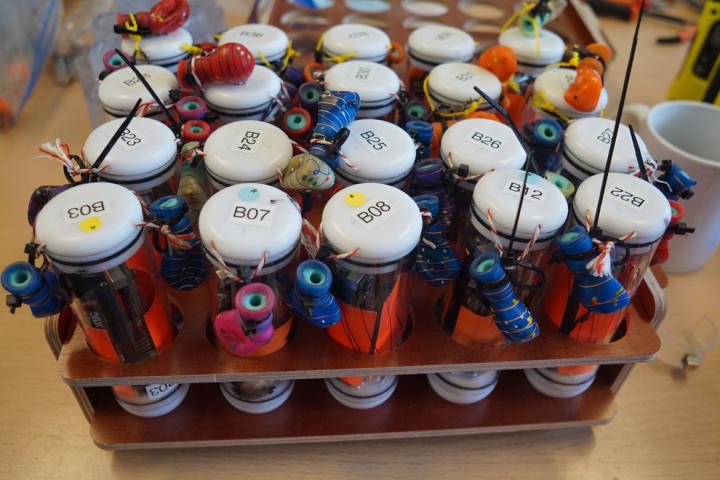
Credit: TalTech
In the Europe-wide FIThydro project, TalTech researchers worked with industry partners to study existing hydroelectric power plants. Together with researchers across Europe, they developed new assessment methods and technologies with the goal of making hydropower more fish-friendly and environmentally sustainable.
Hydropower is one of the most important and widely used renewable energy sources. The big advantage: it is far less weather-dependent than wind power and solar energy. However, the use of hydropower plants also involves major interventions in the environment, including the damming of rivers, changes in aquatic habitats, and fish mortality through turbines, spillways or screens.
Reducing these negative ecological effects is one of the objectives of the European Water Framework Directive. However, older hydropower plants in particular often fail to meet these new requirements and need to be retrofitted before their certification can be renewed. The decision on economically viable measures for implementing these changes have to be made individually for every hydropower plant, “It is important to tailor existing solutions to the site-specific factors of each plant,” explains Prof. Peter Rutschmann from the Technical University of Munich and coordinator of the FIThydro project.
Studying hydropower plants across Europe
In the four-year EU project FIThydro (Fishfriendly Innovation Technologies for Hydropower), a work group made up of 26 European research institutions and companies studied the effects of hydropower plants on ecosystems and in particular fish at 17 test sites in eight countries. “It was important to us that the test sites reflect the diverse geographical, hydromorphological and climate conditions so that our results would be applicable to a wide range of hydropower plants in Europe,” explains Prof. Rutschmann.
“Electronic fish” measure turbine passage
There are also gaps in the existing knowledge on effective upstream and downstream fish migration measures – such as which fish ladders are suitable for which species or which conditions are ideal for fish to find them. During downstream migration, fish can swim through the hydropower turbines and, apart from the risk of injury from the turbine blades, are exposed to enormous pressure changes. “With these sensors, we can test the extreme conditions fish and other aquatic life experience passing through turbines. This can help to reduce the number of live fish experiments needed, and provide operators with new insights into how they can make their facilities more fish-friendly” explains Dr. Jeffrey Tuhtan, who leads the sensor team at TalTech.
To compare the sensors with the experience of live fish, colleagues from INBO Belgium together with TalTech investigated the multispecies risk of injury and mortality during downstream passage through a large Archimedes hydrodynamic screw for bream (Abramis brama), eel (Anguilla anguilla), and roach (Rutilus rutilus) in conjunction with passive sensors that record the pressure, acceleration, and rate of rotation. “Our work came up with several new ways to assess downstream passage for fish and sensors including the times and durations of impact events, the kinetic energies of translation and rotation, and the pressure gradient” said Dr. Ine Pauwels from INBO. The team found that the screws were not always fish-friendly and proposed concrete ways to improve the situation for both operators and fish.
Decision making tools for hydropower operators
Along with the risk analysis and assessment of hydropower plants, the second part of the project explored possible measures to retrofit hydropower plant – as well as decision making tools for hydropower operators and planners. “These decisions are highly complex,” says Prof. Rutschmann. “The hydropower plant and the site-specific conditions play a role. But it is also necessary to comply with regulatory standards on the national and EU level. And for the operators it is of course important for the measures to be effective and cost-efficient.”
Open-access online tools
One of the main results of the project is the FIThydro Decision Support System that can be used when planning and assessing hydropower plants. The user can enter data on the type of the power plant, its location, the fish populations present in the waterways and other characteristics. Taking into account environmental policy requirements and international regulatory guidelines, the software then analyses the data to calculate the level of environmental risk and the fish population hazard and recommends mitigation measures.
A wiki has also been created in the project. “There are different practices in every country, but the knowledge exchange is not yet where it should be,” says Prof. Rutschmann. “For example, people are often unaware of measures that have been tried out and found to be efficient elsewhere. We hope that the wiki will support the networking of knowledge.”
###
More information:
- FIThydro Website: https:/
/ www. fithydro. eu/ - FIThydro Decision Support System: http://www.
dss. .fithydro. wb. bgu. tum. de/ home/ ui - FIThydro Wiki: https:/
/ www. fithydro. wiki/
Source: 21.10.2020 Sustainability „Multi-Species Assessment of Injury, Mortality, and Physical Conditions during Downstream Passage through a Large Archimedes Hydrodynamic Screw (Albert Canal, Belgium)” https:/
The research project “Fishfriendly Innovative Technologies for hydropower (FIThydro)” (https:/
Additional information: Dr. Jeffrey A. Tuhtan
TalTech Centre for Biorobotics, [email protected], [email protected]
Media Contact
Jeffrey Andrew Tuhtan
[email protected]
Related Journal Article
http://dx.




